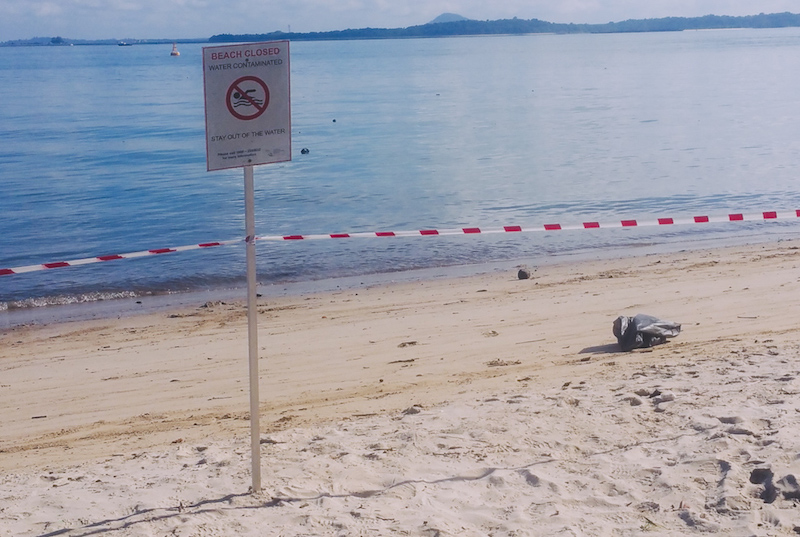Following yesterday’s report of oil spillage, I went down to Changi Beach, one of the many affected sites, to observe the beach-cleaning progress.
The time was 9.35am when I arrived. The smell of the sea was faint, but unmistakably tainted with the lingering scent of raw oil in the air. It’s not that revolting, I thought, having come prepared with a trusty tub of Tiger Balm in my pocket — but the whiff of petroleum was undeniable, nonetheless.
The morning populace was small, and while the numbers weren’t exactly scarce, the people present (who weren’t NParks staff or beach workers) were far and few between, with the occasional cyclist (majority of them were by their lonesome) passing by every few minutes. The entire beach was practically silent, save for the crashing of seawater against the shore and the occasional aircraft passing by. Not much difference; except for the fact that the beach was closed.

Notably, plenty of trash was seen laying around the shorelines, and more still floating in the waters. The entire stretch (from BBQ Pit 1 down to Pit 12) was cordoned off by the tapes wrapped around signposts along every few metres. Trash bags lined in pockets along the signposts, and even a lone shovel was left upright in the sand.
Only thing that was missing from the whole scene: The workers themselves.

While looking out for workers I could talk to, I approached a couple of curious beach-goers/bystanders who had been taking pictures of the shorelines up close. Watching them frame up their shots (while simultaneously shaking their heads and doing tsk-tsks of disapproval), I asked them what they thought of the ruined beach.
One jogger, who requested not to be identified, called the whole incident an “unfortunate thing”.

“Collisions do happen from time to time, I guess. All we can do is just be ready for cases like this, as there’s nothing much we as civilians can do since tankers go through the straits all the time,” he said. “The response and swift actions taken to contain this situation has been very good, though the cleaning process is still ongoing.”
Another passerby, who wished to be known as Mr Tan, gave a curt response. “It’s just human error, what else can we say about this?” he muttered. Yeah, thanks a lot, Mr Tan.

As it turns out, my hunt for workers in the clean-up led me to the river mouth area of Changi Point Ferry Terminal, where work is still being carried out on both sides of the river shorelines. Thankfully, one of the workers was friendly enough to humour me for a quick chat.

So, how long have you guys been conducting the clean up?
We’ve been at it since yesterday morning, clearing the contaminated sands until now.
How are you going about cleaning up the spillage on the beach?
It’s pretty simple — we use a shovel to scoop up the oil-contaminated sands, and then we dump them in the trash bags, which we’ve prepared around our waists.

Simple indeed. How long more till you guys finish the whole operation?
It’s hard to say. Even if we’ve made the beaches free of oil contamination, there’s still oil residue floating in the waters. It’s really hard to judge the approximate duration this project will take.
Are there more spots here affected by the oil spill?
We’ve pretty much cleaned up over half of this (entire Changi Beach) area, so the ones we’re at (Changi Point Ferry Terminal to BBQ 1-12) are left, I think. There’s that, at least (points to the other side of the river mouth where another group of workers are cleaning the shores with a laugh).

What about the wildlife at the beach — are they being affected?
I haven’t really seen any animals or fishes while we’ve been working, truth be told. It’s possible that I’ve just been ignoring them and not paying attention, because all that’s left around the beaches are crows trying to pick at the floating garbage washed ashore (laughs)!
How many workers are involved in the clean-up right now?
Currently, this stretch is split into different segments, with an average of two to three workers at any given segment. Not all segments are worked on, since once we’re done with one, we move on to the next. Depending on how bad the contamination is for that segment, there may be more deployed to help speed things up.
Sounds like a tough job, no?
I wouldn’t say there are any challenges, since (the equipment) we’re provided are straightforward in their usage.
Hats off to you and your team, good sirs. Cleaning up the beach while going through all the garbage littered by fellow Singaporeans is a hell of a job.






Reader Interactions